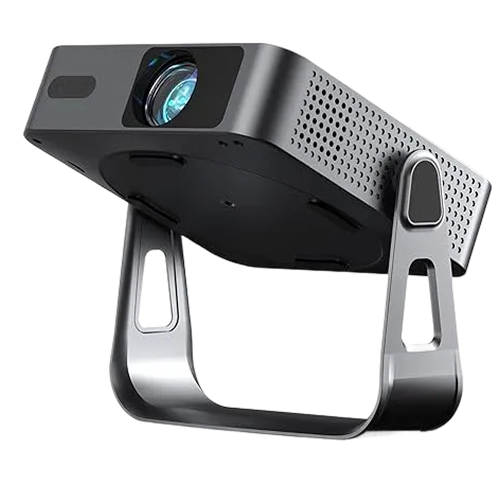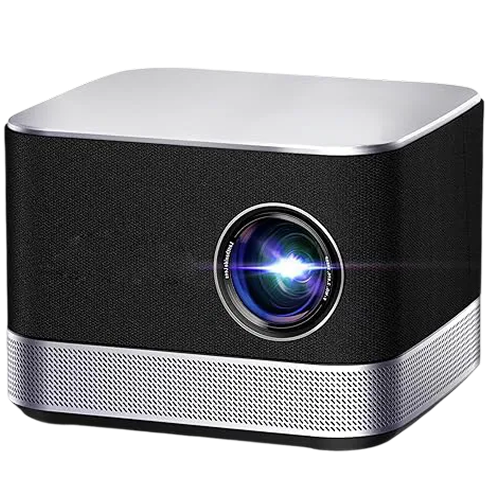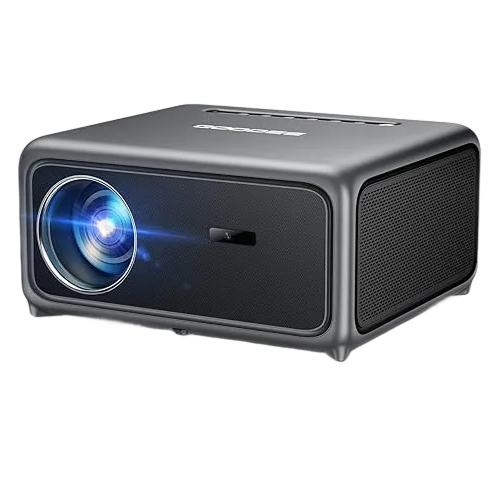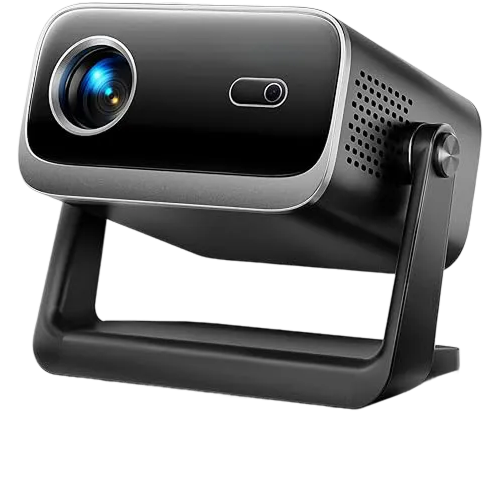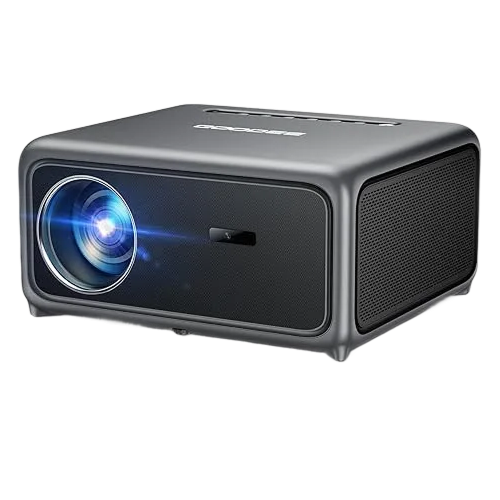Gaming on a projector is an experience I absolutely recommend. The immersion you get from a 120-inch screen transforms single-player adventures and makes racing simulators feel real. But walk into this purchase blind and you’ll end up with a beautiful cinema projector that turns your favorite shooter into a slideshow.
I’ve worked with hundreds of gamers who made expensive mistakes because they didn’t understand what separates a gaming projector from a home theater model. This guide will help you avoid those pitfalls.
What Makes a Gaming Projector Different?
Gaming projectors prioritize responsiveness over picture processing, while home theater projectors load images with enhancement algorithms that improve color and smooth motion.
The processors in home theater projectors add 40-80 milliseconds of delay between your controller input and the screen response. That lag makes competitive gaming frustrating and action games feel sluggish.
Gaming projectors do away with the processing. And, as a result, display images with minimal delay, usually under 20 milliseconds. You’ll sacrifice some picture refinement, but your gameplay feels immediate and responsive.
Gaming projectors differ from home theater models in three ways:
- Dedicated game modes bypass image enhancement, reducing lag from 60ms in cinema mode to 16ms.
- Higher refresh rates (120Hz or 240Hz versus 60Hz) enable smoother motion during fast action.
- DLP technology eliminates the motion blur that LCD panels produce during camera pans, which matters when tracking opponents or navigating tight racing lines.
Recommendation: Choose a dedicated gaming projector for first-person shooters, racing games, fighting games, and competitive titles where sub-20ms lag matters. Story-driven games and turn-based titles work perfectly on cinema projectors with their superior image processing. But if you want a deeper understanding of dedicated home theater setups, see our home theater projectors guide.
Input Lag
Input lag measures the delay between pressing a button and seeing the result on screen. This specification determines whether a projector works for gaming.
Games display motion through individual images called frames. At 60 frames per second, your screen shows 60 different images every second, with each frame lasting 16.7 milliseconds. When you press a button, the projector needs time to process that input and display the corresponding action on screen. Input lag measures this processing time.
Lower input lag means your actions appear on screen faster. Here’s what different lag measurements feel like in practice:
Testing methodology varies between manufacturers. Therefore, always verify measurements at your intended resolution and refresh rate, since a projector advertising 4ms lag might only achieve that at 1080p/240Hz while delivering 30ms at 4K/60Hz.
Recommendation: Target projectors with 10-20ms input lag for serious gaming. Competitive players should stay under 15ms, while single-player focused gamers can accept up to 30ms without major frustration.
Refresh Rate and Frame Rate
Refresh rate determines how many times per second the projector updates the image. Higher refresh rates produce smoother motion and reduce blur during fast action.
That said, your console or PC sends out frames, and your projector displays them at its own refresh rate. When these two speeds don’t align, you get screen tearing (horizontal lines splitting the image) and stuttering (choppy, jerky motion). Both disrupt gameplay and pull you out of the experience.
For perspective: Suppose your PC renders a game at 100fps but your projector only supports 60Hz. The extra frames get discarded and you see screen tearing. VRR (variable refresh rate) technology solves this by synchronizing the projector’s refresh to match the varying frame rate output.
Modern gaming runs at varying frame rates, and here’s a quick guide:
Recommendation: Console gamers should prioritize 120Hz support at 1080p or 1440p to access performance modes on PS5 and Xbox Series X. PC gamers need at least 120Hz for competitive play, while casual single-player gaming works fine at 60Hz.
HDMI Specification
HDMI specification determines which resolution and refresh rate combinations your projector accepts. This technical detail causes more buyer regret than almost anything else, so let’s gain some perspective:
Real-world impact shows up when you connect a PS5 to a projector with HDMI 2.0b. Modern consoles offer performance modes that prioritize frame rate (targeting 120fps at lower resolutions like 1080p or 1440p) or quality modes that prioritize visual fidelity (native 4K resolution at 60fps with enhanced graphics settings). Your HDMI 2.0b projector blocks the 4K/120Hz option entirely, forcing you to choose between smooth motion at 1080p/120fps or sharp visuals at 4K/60fps.
The port count matters too. Multiple HDMI inputs eliminate cable swapping between consoles, PCs, and streaming devices. Gaming projectors should include at least two HDMI ports.
Recommendation: Verify both HDMI version and port capabilities before purchasing. Some projectors include HDMI 2.1 on one port and HDMI 2.0 on others, so connect your primary gaming device to the correct port for full access to 4K/120Hz and performance modes.
Display Technology | DLP vs LCD vs LED
Display technology determines motion clarity, response time, and whether you experience the rainbow effect.
DLP (Digital Light Processing)
DLP dominates gaming projectors because the technology produces instantaneous pixel response. A DLP chip contains millions of microscopic mirrors that flip thousands of times per second, creating perfect motion clarity with zero blur when your character spins the camera or navigates tight racing lines.
Most DLP projectors use a single chip with a spinning color wheel that rotates through red, green, and blue segments. Your eye blends these colors into full-color images, but the color wheel creates a side effect called rainbow effect where some viewers see brief color separation flashes on high-contrast edges.
About 30-40% of people notice it occasionally, while 10-15% find it distracting enough to rule out DLP entirely. However, higher refresh rates and RGB color wheels reduce visibility, and LED/laser light sources eliminate color wheels entirely.
LCD (Liquid Crystal Display)
LCD projectors use three separate panels (one each for red, green, and blue) that simultaneously create the full-color image, eliminating rainbow effect completely. The trade-off comes from LCD response time, since liquid crystals transition between states over several milliseconds. During fast motion, pixels are still transitioning from the previous frame when the new frame arrives, creating motion blur and ghosting.
Light Sources | LED vs Laser
LED and laser both offer instant on/off, lower heat, and quieter fans. LEDs appears in DLP projectors under $800 with portable designs. Laser combines with both DLP and LCD in the premium range, delivering brightness for larger screens without sacrificing response time.
Recommendation: DLP with LED or laser works best for most gaming scenarios (budget $800-1,500). Choose 3LCD with laser if you’re sensitive to rainbow effect (expect $1,500-2,500). Avoid lamp projectors due to ongoing replacement costs.
Resolution: 4K vs 1080p for Gaming
Resolution determines image sharpness at large screen sizes. Gaming projectors complicate this because resolution interacts with refresh rate, HDMI bandwidth, and pixel-shifting technologies.
Native 4K (3840 x 2160)
True native 4K projectors use panels with 8.3 million physical pixels. Text stays crisp on 120+ inch screens, and open-world games showcase environmental textures better than 1080p. Most native 4K projectors force you to choose between 4K/60Hz or 1080p/120Hz, since true 4K/120Hz requires HDMI 2.1 and appears only in premium models starting around $2,000.
Pixel-Shifted 4K (0.47-inch DLP)
Most “4K” gaming projectors under $1,500 use pixel-shifting. These projectors employ 1920 x 1080 DLP chips that rapidly shift pixels diagonally to create 3840 x 2160 addressable pixels. This delivers image quality between true 4K and 1080p at $800-1,500 price points, and higher refresh rates come easier since the base panel runs at 1080p.
Native 1080p (1920 x 1080)
Native 1080p projectors work well up to 100-110 inch screens. Beyond that size, you see individual pixels from typical viewing distances. This resolution enables high refresh rates up to 240Hz, and budget options under $800 deliver good gaming performance.
For a deeper comparison of 4K projector types, screen size calculations, and image quality differences, check our comprehensive 4K projectors guide.
Recommendation: Console gamers should target pixel-shifted 4K projectors with 120Hz at 1080p ($1,000-1,500 range). PC gamers with mid-range hardware benefit from native 1080p at 120-240Hz to maximize frame rates. Only invest in native 4K/120Hz ($2,000+) if you have high-end hardware and want screens above 135 inches.
Brightness Requirements by Screen Size
Brightness determines your maximum usable screen size and how much ambient light the projector tolerates. Gaming projectors need more brightness than cinema models because gaming often happens during daytime or with some lights on.
Brightness gets measured in ANSI lumens. Many budget projectors advertise “LED lumens” or “light source lumens” inflated 3-10x over actual ANSI output. ANSI lumens follow standardized testing that measures actual light output at the screen, so always look for this specification.
Recommendation: Match brightness to your intended screen size and typical room lighting. A 100-110 inch screen needs 1,500-2,500 lumens for gaming with some ambient light, while 120+ inch screens require 2,500+ lumens. Avoid buying excessive brightness for future-proofing since extra lumens in dark rooms just reduce contrast and increase fan noise.
Contrast Ratio and Black Level Performance
Contrast ratio measures the difference between the brightest white and darkest black a projector produces. Higher contrast creates depth, improves dark scene visibility, and makes colors appear more saturated.
Ignore dynamic contrast specifications. Manufacturers measure these by closing an iris or dimming the light source during black scenes, then opening fully during bright scenes. These measurements reach absurd numbers like 1,000,000:1 but don’t reflect real-world performance within a single frame.
Native contrast (measured with consistent settings) is what you should look for and this is what to expect:
But remember, room lighting affects contrast more than the specification itself. You’ll get better black levels from a 2,000:1 projector in complete darkness than from a 5,000:1 model in a room with ambient light washing out the screen.
Recommendation: Target 2,500:1 to 5,000:1 native contrast for quality gaming under $2,000. This range maintains detail during cave exploration and night missions while handling bright action sequences well. Higher contrast ratios (5,000:1+) provide diminishing returns for gaming unless you play primarily dark horror titles or story-driven games with cinematic visuals.
Throw Distance and Placement
Throw distance determines how far back you position the projector to create a specific screen size. Different projector types require different distances, and here’s an approximation of what you can expect (optical zoom capabilities might affect these distances):
Standard throw projectors need about 8-12 feet to create 100-inch images. Many gaming projectors under $2,000 fall in this category.
Short throw projectors need about 4-6 feet for 100-inch images. These work in smaller rooms but cost more at equivalent specifications. For comprehensive short throw guidance, see our dedicated short throw guide.
Ultra short throw projectors need 0.5-1.5 feet for 100-inch images. They sit directly below the screen, avoiding shadows and cable runs.
The majority, if not all, projector manufacturers provide throw distance calculators on their website. Input your desired screen size and the calculator shows required mounting distance. Check this before buying.
Alternatively, you can use the formula:
Throw Distance = Screen Width × Throw Ratio (the throw ratio is listed in the projector’s specifications).
Recommendation: Always verify throw distance requirements before purchasing. Standard throw projectors work for most gaming setups with 8-12 feet of space, while short throw (4-6 feet) and ultra short throw (0.5-1.5 feet) models suit smaller rooms but cost more. Check gaming specifications carefully on UST projectors since budget models often sacrifice input lag for brightness.
Game Mode and Advanced Gaming Features
There are three features that determine how responsive and smooth your gaming experience feels:
Game Mode
Almost every projector includes multiple picture modes. Cinema mode processes images extensively for color accuracy while game mode bypasses processing to minimize input lag. Gaming mode typically reduces input lag by 20-40ms compared to cinema mode on the same projector, so a projector measuring 15ms in game mode might measure 55ms in cinema mode.
Variable Refresh Rate
VRR synchronizes the projector’s refresh rate with your console or PC’s frame rate output, preventing screen tearing and stuttering during frame rate fluctuations. PS5, Xbox Series X, and modern PCs all support VRR through HDMI 2.1, and the impact shows most in games with unlocked frame rates or those targeting 40fps modes.
Auto Low Latency Mode
ALLM automatically switches the projector to its lowest-latency mode when gaming content is detected, eliminating the need to manually enable game mode. This convenience feature activates game mode when you turn on your console and switches back to cinema mode when you launch streaming apps.
Recommendation: Always enable game mode manually for gaming sessions if your projector lacks ALLM. VRR and ALLM appear in premium models at $800+ price points and improve the experience. However, prioritize low input lag and high refresh rate first since a projector with 15ms lag and 120Hz performs well regardless of VRR presence.
Fan Noise
Fan noise affects viewing comfort during long gaming sessions, with levels varying widely across different projector types and price ranges.
For reference, 25 dB equals a whisper, 30 dB resembles a quiet library, and 40 dB matches background conversation. Every 3 dB increase represents a perceived doubling of loudness.
Higher brightness modes increase fan speed proportionally. Laser projectors generally run quieter than LED, which run quieter than lamp-based systems. And ceiling mounting positions fans farther from viewers, reducing perceived noise.
Recommendation: Target projectors under 30 dB if you game without headphones or prefer quiet environments. Headphone users can accept up to 35 dB without issue since game audio masks fan noise effectively.
Budget Tier Recommendations
Gaming projector pricing separates into distinct tiers with predictable performance at each level.
Choosing the Right Gaming Projector
Large-screen gaming delivers something monitors and TVs simply can’t match. Getting the best experience requires prioritizing input lag and refresh rate over resolution, since these specs determine how responsive gameplay feels. On the other hand, brightness sets your maximum screen size, display technology affects motion clarity, and HDMI specification unlocks high frame rate gaming modes.
The $800-1,500 range delivers the best performance per dollar, including pixel-shifted 4K, 1,500-2,500 lumens, 10-20ms input lag, and 120Hz refresh rates. Here’s what I recommend based on your gaming style:
- Console gamers (PS5/Xbox Series X) should target the $800-1,500 range for pixel-shifted 4K with 120Hz at 1080p. VRR and ALLM improve console gaming significantly since frame rates fluctuate during intense gameplay.
- Competitive PC gamers (esports, shooters, fighting games) need the $800-1,500 range focused on response time over resolution. Cap frame rates to match projector refresh rates for optimal performance.
- Single-player PC gamers benefit from the $1,500-2,500 range where image quality takes priority. Larger screens (120-135 inches) benefit from higher brightness in this tier.
- Racing and flight sim enthusiasts should target the $1,000-2,000 range with DLP technology for motion clarity. Ultra-short throw eliminates shadows from steering wheels and cockpit hardware.
- Family and casual gamers work well in the $800-1,500 range prioritizing versatility over specialization. Portable models with auto-keystone work for multi-room setups.
- Outdoor gamers need 2,500+ lumens minimum in the $600-1,500 range. Plan sessions after sunset and budget for Bluetooth speakers since projector audio fails outdoors.
That said, control your gaming environment with proper lighting management and screen selection. And, above all, research specific models thoroughly and prioritize real-world reviews over marketing claims. When chosen and set up correctly, gaming projectors deliver immersion impossible on traditional displays.


